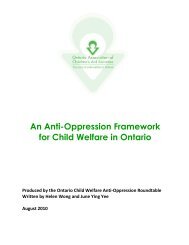English - Ontario Association of Children's Aid Societies
English - Ontario Association of Children's Aid Societies
English - Ontario Association of Children's Aid Societies
Create successful ePaper yourself
Turn your PDF publications into a flip-book with our unique Google optimized e-Paper software.
<strong>Ontario</strong> has an amazing diversity <strong>of</strong> First Nations people. The original<br />
people in <strong>Ontario</strong> were from a number <strong>of</strong> different Nations. Residents<br />
<strong>of</strong> <strong>Ontario</strong> who do not have Aboriginal heritage are guests <strong>of</strong> the First<br />
Nations people. The Métis peoples represent the creation <strong>of</strong> a new<br />
people and culture that were born <strong>of</strong> the original European visitors<br />
and First Nations people. The Inuit have recently become part <strong>of</strong><br />
the <strong>Ontario</strong> Aboriginal population, as they descended from the<br />
Arctic to meet their individual health needs and seek educational<br />
opportunities.<br />
<strong>Ontario</strong> is a gathering place for Aboriginal peoples, particularly<br />
in larger urban settings. To effectively work with Aboriginal<br />
families, child welfare pr<strong>of</strong>essionals require:<br />
> An understanding <strong>of</strong> the demographics <strong>of</strong> Aboriginal peoples,<br />
> A history <strong>of</strong> the particular Nation or Clan that they are<br />
working with and,<br />
> > An understanding <strong>of</strong> the impact <strong>of</strong> that history on the socio-economic<br />
conditions <strong>of</strong> Aboriginal peoples today.<br />
Because <strong>of</strong> the diversity <strong>of</strong> the communities and peoples that child welfare<br />
pr<strong>of</strong>essionals service, the brief history in this section is designed to be a brief<br />
introduction in your own individual research about the particular demographics <strong>of</strong><br />
your community.<br />
See Appendix A: Glossary <strong>of</strong> terms for explanations <strong>of</strong> the terminology in the<br />
Practice Guide.<br />
This section is intended to help child welfare pr<strong>of</strong>essionals navigate the different<br />
peoples that make up the term “Aboriginal peoples” and the services and resources<br />
to which each group has access. As a child welfare pr<strong>of</strong>essional, you may work with<br />
individuals who identify as:<br />
> > Aboriginal<br />
> > First Nations people (“Indians” as defined in the Indian Act) who live in their<br />
community (on reserve) and have a legal status defined by the federal<br />
government

















